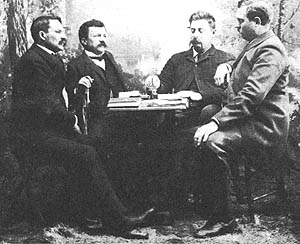 The
mission into Topolobampo was a peaceful one; its goal was to survey the
Pacific Coast of Mexico and Baja California. The survey was ordered by
President Grant at the behest of Albert Kimsey Owen (far left in the
photo), a former railroad surveyor and city planner, who had grandiose
plans to develop a great harbor at Topolobampo.
The
mission into Topolobampo was a peaceful one; its goal was to survey the
Pacific Coast of Mexico and Baja California. The survey was ordered by
President Grant at the behest of Albert Kimsey Owen (far left in the
photo), a former railroad surveyor and city planner, who had grandiose
plans to develop a great harbor at Topolobampo. The harbor was only part of his plans. A railroad would be built from Topolobampo through Mexico and the United States to the Atlantic Ocean, facilitating trade between Europe, the United States, and the Far East. In addition, the area around Topolobampo would be populated with a utopian American colony.
Owen entered into an agreement to purchase 111,000 acres from a local hacienda owner and, with the help of Mexican president Porfirio Diaz, obtained concessions for the railroad and the colony. He then chartered a corporation, Credit Foncier, in New Jersey.
People buying stock in Credit Foncier received the right to join the colony, which was to be run communally and without the use of money. Work was to be assigned according to each person's ability, with credits awarded for labor. Individual accumulation of wealth was prohibited. Eight hours of work, eight hours of sleep and eight hours of culture or entertainment were to make up the daily routine. Colonists would build, own, and operate the railroad, telegraphs, banks, and water supply. Capital gained would be reinvested in the colony's infrastructure.
Credit Foncier clubs sprang up in the United States and Europe. In late 1886 the first 27 colonists arrived from California, and within a short time the population grew to 2,000.
Activities were directed by Owen. A team made daily trips to the Rio Fuerte to gather fresh water. Several towns were founded, connected by paved roads which permitted bicycle travel. Irrigation ditches were dug. A school was opened. Community theater grew, and an Academy of Sciences, with ties to the Smithsonian Institute, was founded.
Governed by the principles of order, industry and courtesy, the colonists attained modest economic success from fishing, farming and hunting. But the colony was growing much faster than Owen had envisioned. It became top heavy—too many planners and not enough workers.
Benjamin Johnson, only 25 years old when he arrived at the colony, challenged Owen's leadership and focused the colonies efforts toward developing a single cash crop—sugar. He received a concession to build a canal from the Rio Fuerte to what became Los Mochis, then convinced the Mexican government to evict most of the Owen colonists.
Owen left, but continued to work on building the railroad, convincing Arthur E. Stilwell, an American railroad owner, to join with him. In 1900 the Kansas City, Mexico and Orient Railroad, precursor to the Chihuahua al Pacifico line, was chartered. The same year the colony was abandoned, having lasted fourteen years.
Today, travelers flying into Los Mochis to begin their tour of Copper Canyon look down on the huge bay and the endless agricultural land, laid out in neat rectangular plots. Little remains of the Owen Utopia, but the area's rich farmlands, and the Copper Canyon railroad are the results of his vision.
Click Here for information on our Copper Canyon Tours.


